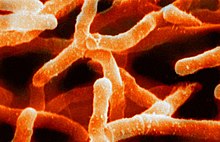Actinobacteria (class)
| Actinobacteria | |
|---|---|
 |
|
| Scanning electron micrograph of Actinomyces israelii. | |
| Scientific classification | |
| Domain: | Bacteria |
| Phylum: |
Actinobacteria Goodfellow, 2012 |
| Classes | |
| Synonyms | |
|
|
The Actinobacteria are a phylum of Gram-positive bacteria. They can be terrestrial or aquatic. They are of great economic importance to humans because agriculture and forests depend on their contributions to soil systems. In soil, they behave much like fungi, helping to decompose the organic matter of dead organisms so the molecules can be taken up anew by plants. In this role the colonies often grow extensive mycelia, like a fungus would, and the name of an important order of the phylum, Actinomycetales (the actinomycetes), reflects that they were long believed to be fungi. Some soil actinobacteria (such as Frankia) live symbiotically with the plants whose roots pervade the soil, fixing nitrogen for the plants in exchange for access to some of the plant's saccharides.
Beyond the great interest in Actinobacteria for their soil role, much is yet to be learned about them. Although currently understood primarily as soil bacteria, they might be more abundant in fresh waters. Actinobacteria is one of the dominant bacterial phyla and contains one of the largest of bacterial genera, Streptomyces.Streptomyces and other actinobacteria are major contributors to biological buffering of soils. They are also the source of many antibiotics.
Although some of the largest and most complex bacterial cells belong to the Actinobacteria, the group of marine Actinomarinales has been described as possessing the smallest free-living prokaryotic cells.
...
Wikipedia
